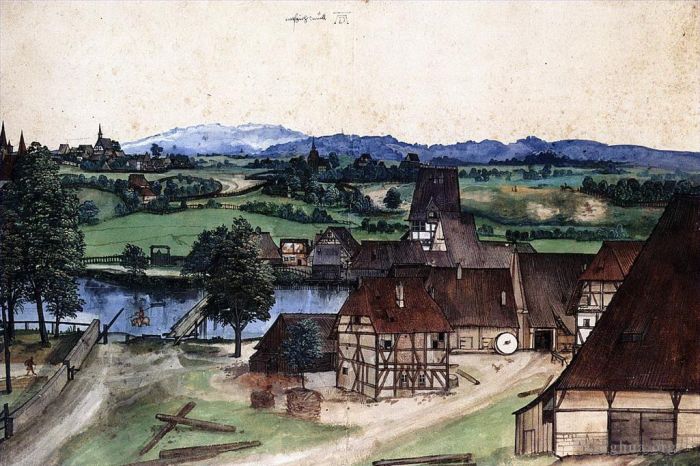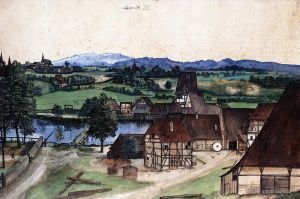The Wire-Drawing Mill
Albrecht Durer
- Price: Price on Request
- Art Type: Various Paintings
- Size:
- English Comments: 0
- International Comments: 0
- Creating Date:
- Introduction and Works of Albrecht Durer >>
Work Overview
- The Wire-Drawing Mill
Albrecht Durer
Date: 1494
Style: Northern Renaissance
Genre: cityscape
Watercolour and gouache on paper
286 x 426 mm
Along with Saint John's Church, this is among Dürer's earliest watercolours, dating either from 1489 or 1494. Inscribed `wire-drawing mill', it depicts a workshop which manufactured copper wire.
From a raised vantage point, our gaze passes over the large and small mills in the meadows on the banks of the River Pegnitz belonging to the city of Nuremberg. The buildings in the foreground are the Grossweiden Mill on the north bank of the River Pegnitz, near St John's Church. A mill wheel leans against one of the buildings. On the far side of the river is the Kleinweiden Mill. Beyond this are villages lying on the outskirts of Nuremberg and the mountains. Dürer has again lavished great care on some of the details, such as the distant houses. His colouring is reminiscent of Netherlandish landscapes, with brown tones in the foreground, greens in the middle ground and bluish mountains in the distance.
Although the detailed composition of the sheet still accords with Late Medieval workshop tradition, the fine glazes, produced with considerably thinned watercolours, already herald the freer brushstrokes of later watercolours. In this respect the sheet can be called a milestone in Dürer's development of the technique of watercolour painting.
Albrecht Dürer was most of the most prolific and influential German artists of the High Renaissance. While Raphael, Michelangelo, and Leonardo were blowing up Italy with their stunning creations, Dürer was redefining art in the North. He was born in 1471 in Nuremberg, a town now famous for the Nazi trials that took place there after WWII. However, in Dürer’s time, the town was part of the Holy Roman Empire. Dürer was a genius and wrote books relating to geometry, human proportions, and art in the natural world. The way he depicted images was so lifelike and precise that his paintings perfectly reflected Alberti’s adage, “a window on the world.” He married in 1494 and worked as an apprentice for an engraver. Perhaps this early exposure to this medium explains why Dürer was such a gifted engraver, woodcutter, and painter. His most famous works are his self portraits, woodcuts of the Apocalypse, and his scenes of nature.
- Copyright Statement:
All the reproduction of any forms about this work unauthorized by Singing Palette including images, texts and so on will be deemed to be violating the Copyright Laws.
To cite this webpage, please link back here.
- >> English Comments
- >> Chinese Comments
- >> French Comments
- >> German Comments
- >>Report
- Emperor Charlemagne
- Virgin Suckling the Child
- Emperor Charlemagne and Emperor Sigismund
- The Apostles Philip and James
- The Cross
- Salvator Mundi
- The Dresden Altarpiece
- St Peter
- Portrait of Emperor Maximilian I
- Alliance Coat of Arms of the Durer and Holper Families
- Portrait of Jacob muffle
- Saint Jerome (St Jerome in the Wilderness)
- Paumgartner Altar right wing
- Portrait of St Sebastian with an Arrow
- Portrait of a Boy with a Long Beard
- Adam and Eve
- The Jabach Altarpiece
- Suicide of Lucretia
- The Seven Sorrows of the Virgin
- Portrait of Oswolt Krel full
- Self-Portrait (Portrait of the Artist Holding a Thistle)
- Four Apostles
- Portrait of a Young Man
- Lots escape
- Portrait of a Man 1504
- Portrait of Hieronymus Holzschuher
- St Jerome
- Twelve year old Jesus in the Temple
- Circumcision of Jesus (Seven Sorrows The Circumcision)
- John
- Christ as the Man of Sorrows
- Holy Family
- The Dresden Altarpiece central panel
- Christ among the Doctors
- Sylvan Men with Heraldic Shields Albrecht Durer
- Job and His Wife
- Maria with child
- The Four Apostles left part St John and St Peter
- The Seven Sorrows of the Virgin The Flight into Egypt
- Portrait of Elector Frederick the Wise of Saxony
- Paumgartner Altar left wing
- Portrait of Elsbeth Tucher
- The Virgin Mary in Prayer
- Ecce Homo
- Portrait of Barbara Durer
- The Madonna of the Carnation
- Portrait of a Young Furleger with Her Hair Done Up
- Combined Coat of Arms of the Tucher and Rieter Families
- Paumgartner altarpiece
- Portrait of a Young Furleger with Loose Hair
- Adoration of the Trinity (Landauer Altarpiece)
- Portrait of Durers Father at 70
- Portrait of a Man 2
- Two Musicians
- The Seven Sorrows of the Virgin Mother of Sorrows
- Portrait of a Young Venetian Woman
- Felicitas Tucher nee Rieter
- Albrecht Portrait of a Man
- Self-Portrait (Self-Portrait with Fur-Trimmed Robe)
- Virgin and Child before an Archway
- Madonna and Child Haller Madonna
- Virgin and child holding a half eaten pear
- The Dresden Altarpiece side wings
- Lot and His Daughters (Lot Fleeing with his Daughters from Sodom)
- Madonna with the Siskin
- Drummers and pipers
- Self-Portrait at 26
- Face a young girl with red beret
- Hans Tucher
- The flight to Egypt Softwood
- Lamentation of Christ
- Hercules kills the Symphalic Bird
- Portrait of the Elder
- Seven Sorrows Crucifixion
- Eve Renaissance
- Avarice
- Virgin and Child with Saint Anne
- Adoration of the Magi
- Martyrdom of the Ten Thousand
- The Lady of the festival du Rosaire
- Emperor Sigismund
- Sylvan Men with Heraldic Shields
- Portrait of Oswolt Krel
- Lamentation for Christ
- The Wire-Drawing Mill
- Primula
- The tuft of grass MINOR
- Garza
- The Little Owl
- Crucifixion
- Cervus Lucanus
- View of Nuremberg
- Lobster
- The Holy Family in a Trellis
- Nuremberg Woman Dressed for Church
- The Castle at Trento
- Innsbruck
- House by a Pond
- Head of an Angel
- Courtyard of the Former Castle in Innsbruck with Clouds
- Lion
- Iris
- Hands
- Hand
- Cupid the Honey Thief
- Self portrait at 13
- View of the Arco Valley in the Tyrol
- Head of a Stag
- The Trefileria on Peignitz
- Arion 2
- Arion
- Knight On Horseback
- A Young Hare
- The Trefileria on Peignitz 2
- Pond in the wood
- Dry dock at Hallerturlein Nuremberg
- Willow Mill
- The Prodigal Son
- View of Kalchreut
- Saint John Church
- Iris Troiana
- The Fall
- Doss Trento
- Innsbruck Seen from the North
- Hare
- Tilo on the cantilever of a bastion
- Courtyard of the Former Castle in Innsbruck without Clouds
- Dead Bluebird
- Map of the Southern Sky
- The city of Trento
- Three Mighty Ladies from Livonia









 Singing Palette
Singing Palette